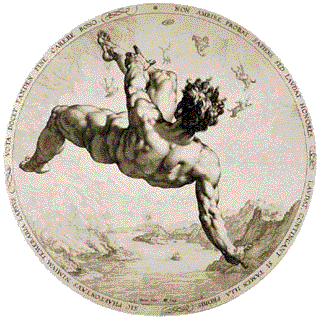1799 · Paris
by Guyot, Edme Gilles
Paris: Librairie rue S. Andre des Arcs, 1799. Three vols., large 8vo. Vol. I: [lacking all 16 preliminary pages including title, and pp. 1-16), 375 (lacking pp. 367-370; pp. 371-375 bound at front); Vol. II: vii, 408 (lacking pp. 409-140); Vol. III: iv, 408 pp. All the engraved plates are present (some folding) numbered 32 + 48 + 22 = 102. VERY POOR CONDITION: in addition to the staining and evidence of damp, many leaves are worn and partially defective. Bound in. EXTREMELY ODD SET OF SCIENTIFIC BOOKS IN ORIGINAL "TEMPORARY" BOARDS WITH PASTEDOWNS OF FRENCH PRINTER'S WASTE, COVERED WITH ENGLISH PRINTED AND MANUSCRIPT WASTE. THE EDGES OF THE TEXBLOCK APPEAR TO HAVE BEEN CRUDELY SAWN OFF, AND INDEED THE WHOLE ENSEMBLE WAS "DECORATED" IN THE MOST PRIMITIVE MANNER IMAGINABLE.
A possible reconstruction of the creation of the books in their current state is here attempted:
We postulate that the present set of scientific books was shipped from Paris to the U.K., probably unbound but sewn in "temporary" boards in accordance with the protectionist import policies designed to help British bookbinders remain competitive (NB: these laws were enacted during the reign of Henry VIII). The leaves that cover the boards are printed (in English) and manuscript (in English), all of which are very difficult to decipher but will no doubt provide more patient scholars hours of bibliographic intrigue. One of the leaves bears the date of 1820, thereby offering a terminus post quem for the application of the paper covers. A printed leaf seems to offer the name of "Halliday (?) & Wilson." Halliday & Wilson Edinburgh milliners active in the early 19th century. Below the name is a long list of various assorted cloths, including "Muslins," and exotic colors such as "Sugar of Lead," "Lytharge," "Spanish Brown," etc. Finally (for now) there is the confounding address which seems to read "6 (?) Commercial St W." It is therefore very plausible that sometime after 1820, the paper covers and edges of the textblock were rudely "decorated" -- in Britain -- with thick brushstokes of the lowest artistic quality. But why?
We have been unable to identify the printer / publisher of the waste sheets, but the text is an unlocated catalogue of books with published prices noted, and with detailed descriptions of each. Of particular interest are translations of three English books into French: "Le aresseux, par le Docteur Johnson, traduit de l'anglois par M. Varney," the sole edition having been published in Paris by Maradan in 1790. Also published by Maradan was "Miss Courtenay, Ou Les Épreuves Du Malheur" (1789). Finally, "La vie de Benjamin Francklin [sic], un des [peres fondateurs des Etats-Unis" (edition indeterminate). Two earlier publications are: "Memoires de la Societe des sciences [physiques] de Lausanne" (apparently the first volume only, published in Lausanne in 1784) and the fourth edition of Vernes' "Confidence Philosophique" which was published in "Londres" in 1788.
HIGHLY CURIOUS. (Inventory #: 4319)
A possible reconstruction of the creation of the books in their current state is here attempted:
We postulate that the present set of scientific books was shipped from Paris to the U.K., probably unbound but sewn in "temporary" boards in accordance with the protectionist import policies designed to help British bookbinders remain competitive (NB: these laws were enacted during the reign of Henry VIII). The leaves that cover the boards are printed (in English) and manuscript (in English), all of which are very difficult to decipher but will no doubt provide more patient scholars hours of bibliographic intrigue. One of the leaves bears the date of 1820, thereby offering a terminus post quem for the application of the paper covers. A printed leaf seems to offer the name of "Halliday (?) & Wilson." Halliday & Wilson Edinburgh milliners active in the early 19th century. Below the name is a long list of various assorted cloths, including "Muslins," and exotic colors such as "Sugar of Lead," "Lytharge," "Spanish Brown," etc. Finally (for now) there is the confounding address which seems to read "6 (?) Commercial St W." It is therefore very plausible that sometime after 1820, the paper covers and edges of the textblock were rudely "decorated" -- in Britain -- with thick brushstokes of the lowest artistic quality. But why?
We have been unable to identify the printer / publisher of the waste sheets, but the text is an unlocated catalogue of books with published prices noted, and with detailed descriptions of each. Of particular interest are translations of three English books into French: "Le aresseux, par le Docteur Johnson, traduit de l'anglois par M. Varney," the sole edition having been published in Paris by Maradan in 1790. Also published by Maradan was "Miss Courtenay, Ou Les Épreuves Du Malheur" (1789). Finally, "La vie de Benjamin Francklin [sic], un des [peres fondateurs des Etats-Unis" (edition indeterminate). Two earlier publications are: "Memoires de la Societe des sciences [physiques] de Lausanne" (apparently the first volume only, published in Lausanne in 1784) and the fourth edition of Vernes' "Confidence Philosophique" which was published in "Londres" in 1788.
HIGHLY CURIOUS. (Inventory #: 4319)

















![[AMERICAN HERBARIUM 1883-1903]. Meticulously compiled and crafted Herbarium Notebook containing 58 botanical specimens from around the globe](https://d3525k1ryd2155.cloudfront.net/h/852/432/1681432852.0.m.jpg)
